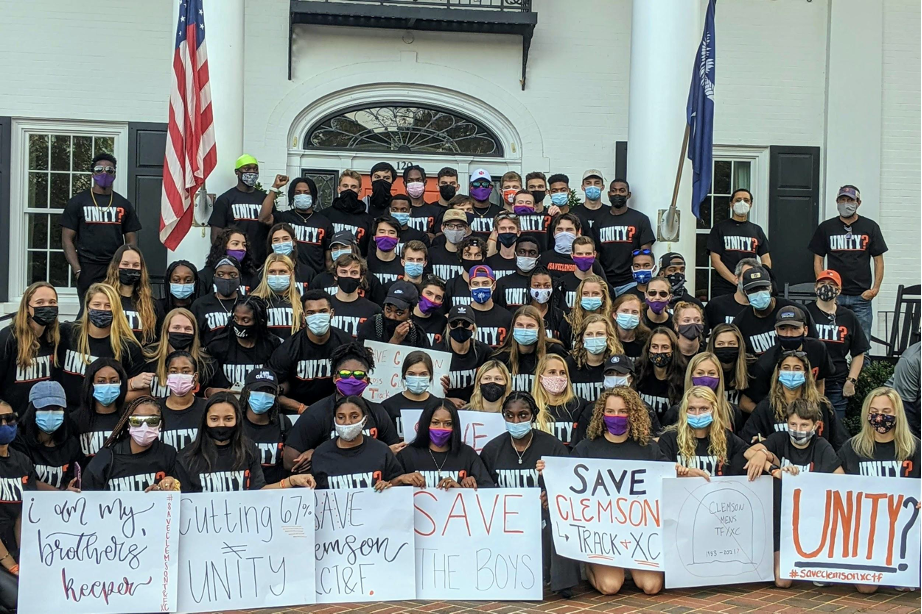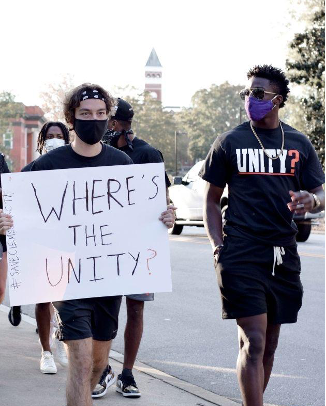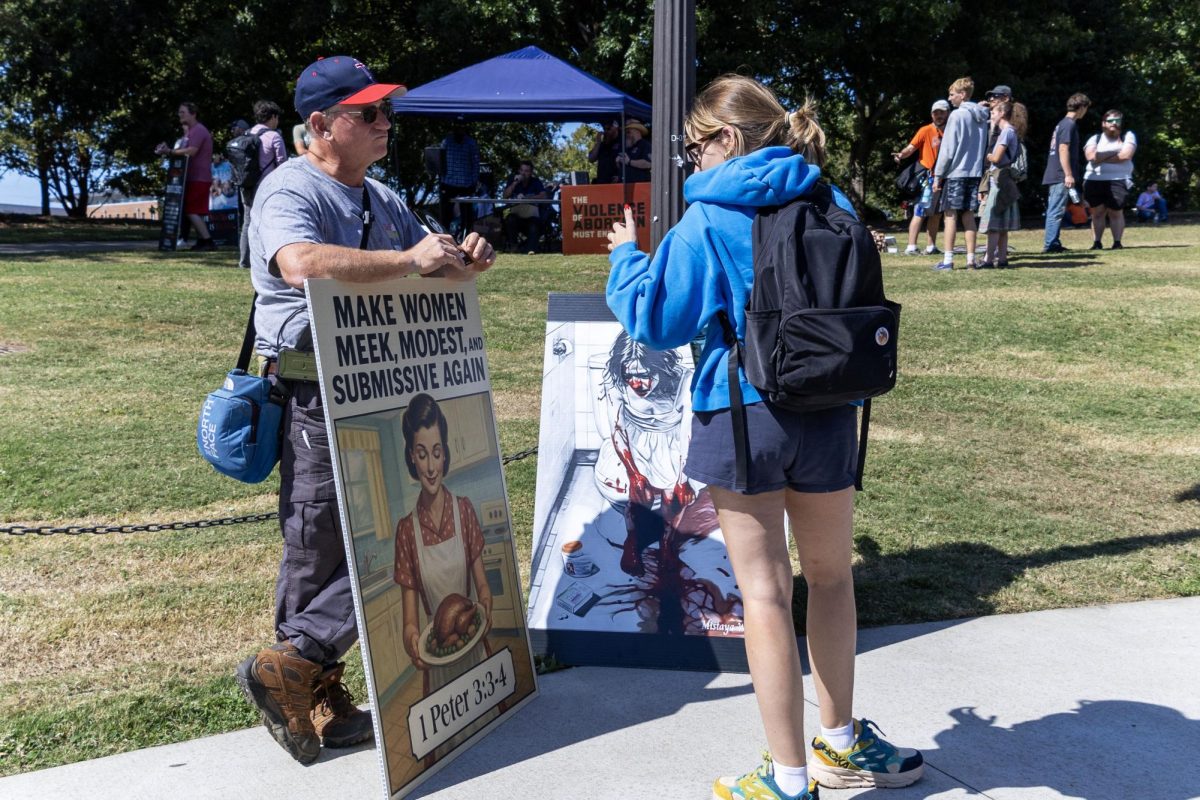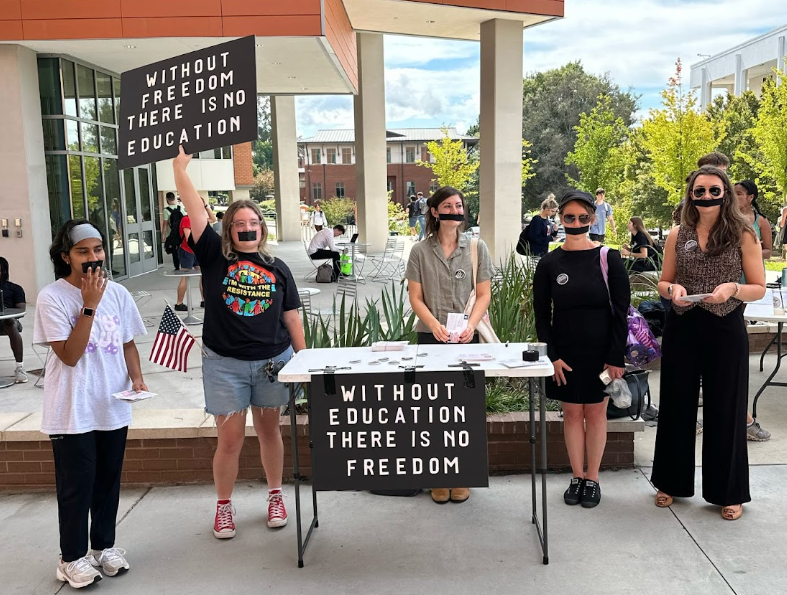On Saturday Nov. 21, members of the Clemson University men’s cross country and track and field program marched from downtown Clemson to President Clements’ house, fueled by anger and disbelief. Accompanied by their families, friends and female teammates, they chanted “Save Clemson track” and proudly held up signs reading “Where is the unity?,” and “Save the boys.” Speakers stood on the front steps of the president’s house to offer words of solidarity and encouragement. The crowd formed a sea of impassioned athletes and supporters, all donning black shirts reading “UNITY?”.
This comes after the unexpected decision to cut the men’s cross country and track and field program announced on Nov. 5. The women’s cross country and track and field teams are unaffected by the decision.
The men’s track and field and cross country athletes will continue to compete until the program officially closes in June 2021. The university will honor all athletic scholarships at their current level of aid until the athletes graduate. They have also committed to assisting athletes who wish to transfer to another institution to compete in track and field.
In an open letter on Nov. 5, Athletic Director Dan Radakovich said Clemson Athletics considered the following factors in making its decision: “competitive balance, gender equity and Title IX compliance, financial positioning, impact on diversity among student-athletes and staff, and local and national interest and participation in the sport.”
Athletes are asking President Clements to overturn the Athletic Director’s decision to cut the program. Members of the men’s cross country and track and field teams started a petition to garner support for their cause, which has been signed by more than 30,000 people.
“I’d always been told that we were a family, and you don’t cut out part of your family,” said Danny Shaughnessy, a distance runner and protest organizer.
The men’s track and field team has amassed a number of titles since the start of the program in 1953, including 23 combined ACC team championships and 16 NCAA individual championships. The program has produced 22 Olympians and four Olympic gold medalists.
Student athletes made it clear that they are not giving up the fight. “The goal here is to make things right,” said Colin Gallagher, a student athlete and protest organizer. “This decision sets a bad precedent for college athletics as a whole and is embarrassing on Clemson’s part to cut 67% of non-revenue-generating black athletes.”
In a press conference on Nov. 5, Radakovich highlighted Clemson Athletics’ commitment to diversity and inclusion. “Our whole campus and certainly our athletic program are committed to racial and ethnic diversity,” he said.
Gathering support and garnering attention
Following the protest, the activists continue to advocate for their cause. Hundreds of people have commented #saveclemsonxctf on Instagram posts on Clemson University’s official account.
On Dec. 1, athletes and supporters called Clemson University trustees in advance of an emergency board of trustees meeting, though the topic did not make it onto the agenda.
The next day, on Dec. 2, Save Clemson Track and Field released a video on social media that highlights key diversity statistics and draws attention to Clemson’s history as an institution largely built by slaves and black convict laborers. The video has been viewed by more than 10,000 people.
The video compares track and field to football and basketball, which are Clemson’s top two revenue-generating sports and both have a high participation rate among black males. It then makes the claim that in cutting the men’s track and field program, “Clemson is saying one thing: we only value black student-athletes if we can make money from them.”
The video was featured in a recent article in Sports Illustrated, adding fuel to the fire of the growing controversy.
Radakovich and other representatives from the athletic department continue to emphasize that the decision to cut the team is final.
The fate of track and field on the line
Student athletes and many members of the track and field community nationwide worry that if Clemson University does not reverse its decision, it could be the beginning of the end for the sport of track and field. Ethan Binnix, a middle distance runner and protest organizer, pointed to the threatened future of the sport. “Clemson is one of the top schools…if this program goes, a lot of other programs are going to go along with it,” he said.
One of the speakers at the protest on Nov. 21 was Russell Dinkins, a former track and field athlete at Princeton University. He helped reinstate the track and field program at Brown University and now works to preserve track and field programs across the country.
Dinkins stood before the sea of black t-shirts, lowered his Clemson orange mask, and delivered a striking speech that cut right to the heart of the issue. “Universities look at you all as commodities and if you are not a commodity that they can exchange for profit, they can discard you” he said. He painted a picture of the unique opportunities provided by track and field:
“Track and field is one of the few sports where you don’t have to join a travel team, you don’t have to go to an expensive sports camp, [and] you don’t have to hire a sports consultant…It doesn’t matter if you’re from the middle of nowhere or a big city…You can be anybody, anywhere, from any meager means and still make it.”
A pathway to a higher education
Dinkins finished his speech on the steps of the president’s house with the bottom line. “What is supposed to be important about sports in college is providing an [educational] opportunity by way of athletic performance” he said.
According to a 2019 survey by the Aspen Institute’s Project Play, track and field is the least expensive sport children can participate in, costing families an average of $191 per year. Cross country is the fourth least expensive sport out of 21, costing families an average of $421 per year. The relatively low cost of each of these sports makes it easier for students from low socioeconomic backgrounds to participate.
The barriers to entry for other sports are frequently much higher, meaning that athletes from a wealthier background have an advantage and are more likely to play those sports in college. For example, field hockey, lacrosse and gymnastics all cost families more than $1,000 per year according to Project Play.
Sports can provide a pathway to a high-quality education that for some students would not be otherwise available. Many students rely on athletic scholarships to help pay for their tuition. According to the NCAA website, division I and II schools provide more than $3.6 billion in athletic scholarships annually to more than 180,000 student athletes.
Reckoning with diversity
In the open letter on Nov. 5, Radakovich referenced the cost savings to the Clemson Athletics department as a result of cutting the program. “The annual $2-million plus in savings will be reinvested into other athletic department initiatives, including our remaining Olympic sports,” he wrote.
Gabrielle Garringer is an organizer of Save Clemson Track and Field. Her brother is a member of the men’s cross country team. She explained how the transfer of money away from the men’s cross country and track and field program will impact non-white Clemson athletes. “Unfortunately, the other Olympic sports tend to be predominantly white…It’s basically a transfer of wealth from a diverse sport to a predominantly white sport.”
According to Jeff Kallin, Associate Athletic Director for Strategic Communications, currently about 31.5% of student athletes at Clemson self-identify as black or two or more races. This number will fall to about 29.5% following the discontinuation of the men’s track and field program. The average among NCAA power five institutions is around 24.1%. From this perspective, the percentage of black and multi-racial student athletes at Clemson falls above the average of its peer institutions.
Track and field is one of the most racially diverse sports in college athletics. Dinkins aggregated eight years of Division I data from the NCAA and found that track and field had the third highest participation rate among black males, preceded only by football and basketball. However, black students account for just over 16% of all athletes in the NCAA, according to its Race and Gender Demographics Database.
What about the women?
When the men’s track and field team officially expires in June 2021, the number of coaches for the track and field program will be reduced from six to three in order to stay in compliance with NCAA regulations.
Andrea Foster, a member of the women’s track and field team, expressed concerns that having fewer coaches could negatively impact the performance of the women’s team. With fewer coaches, it will be more difficult to provide specialized training to each different type of track and field athlete. “You can’t ask a pole vaulter coach to coach a hurdler,” she said.
“I came from a junior college and I had a coach who was not specialized in a specific event. That one coach tried to coach everybody and it was really chaotic, some days I was training myself,” Foster said. “For that to happen at a top five school, it would really be devastating…No top tier athlete is going to want to attend a school that doesn’t have a male and a female team.”
With the discontinuation of the men’s team, the number of athletes in the track and field program will be reduced from 96 to 45. Kallin said the reduced number of coaches corresponds with the reduced number of athletes and that in addition to three full-time coaches, the paid staff will be supplemented with volunteer coaches.
The trouble with Title IX
Title IX compliance appears to be one of the biggest factors in the decision to cut the men’s track and field program. “Clemson Athletics basically had to make the decision one way or the other to add — it would have to be probably several women’s sports — to offset the men,” said Kallin.
Title IX regulations require that the number of male and female athletes be “substantially proportionate to their overall enrollment,” according to the US Department of Education. The student population at Clemson University is evenly split, with 50% female students and 50% male students.
According to Kallin, the Clemson athletic department is currently made up of 56.3% male athletes and 43.7% female athletes. In order to make the gender breakdown of Clemson athletes more similar to the gender breakdown of the student population, Clemson Athletics had to decide between adding women’s sports or cutting men’s sports. They decided that discontinuing the men’s track and field program would be the best way to realign athlete demographics with Title IX requirements.
Efforts continue
Anthony Hamilton, a high jumper and protest organizer, emphasized that despite the many hurdles, he and his teammates are not giving up hope. “We are going to keep fighting no matter what they are saying,” he said. “[W]e are going to try our best to save this program.”
After detailing the importance of track and field as a low-cost, highly accessible and highly diverse sport, Dinkins highlighted the reason he continues to fight alongside college athletes to preserve track and field programs nationwide. “Track and field is a sport that should not be on the chopping block at these universities.”
Clemson student athletes Danny Shaughnessy and Anthony Hamilton lead the crowd of protesters past Sikes Hall.










